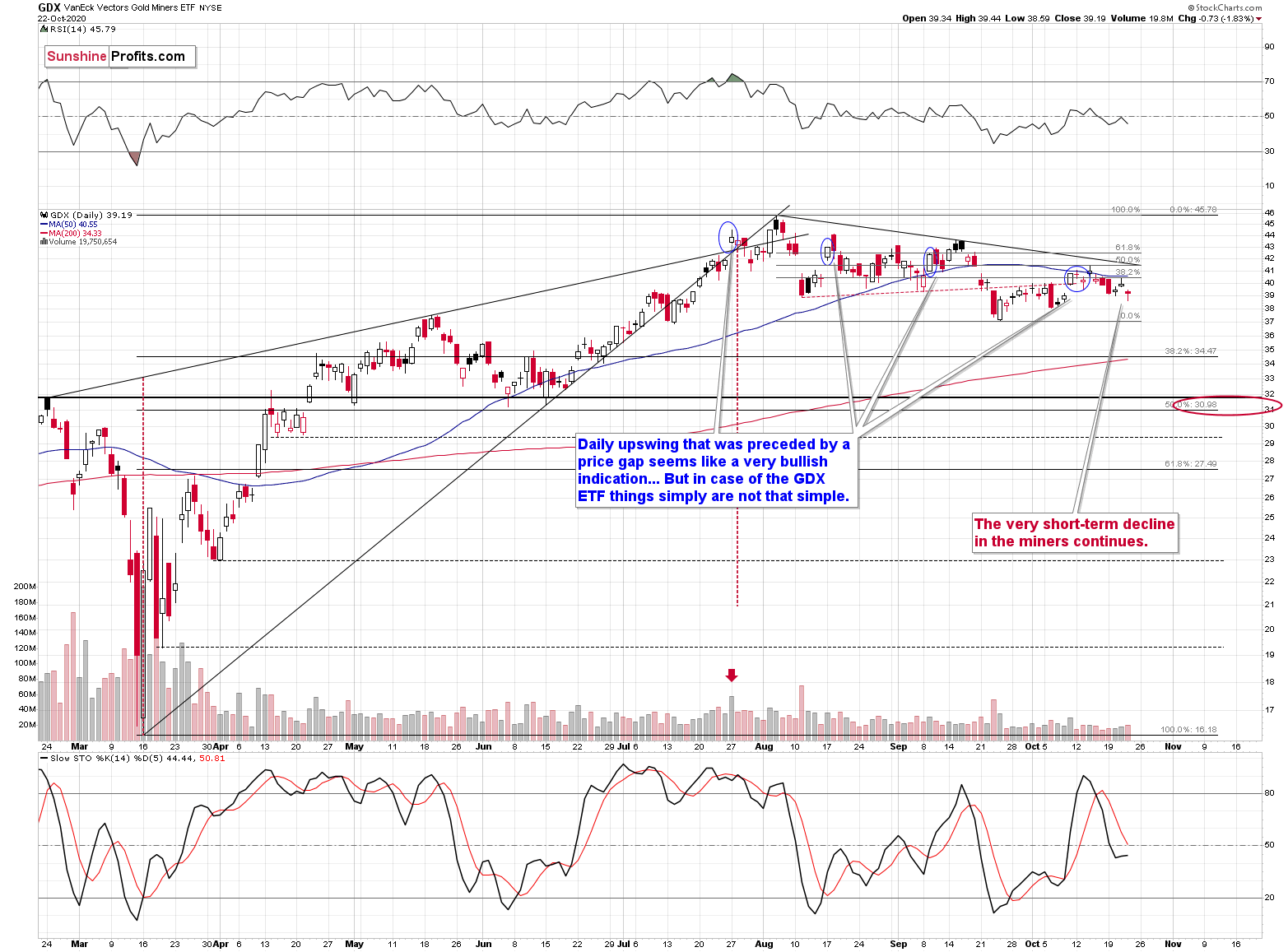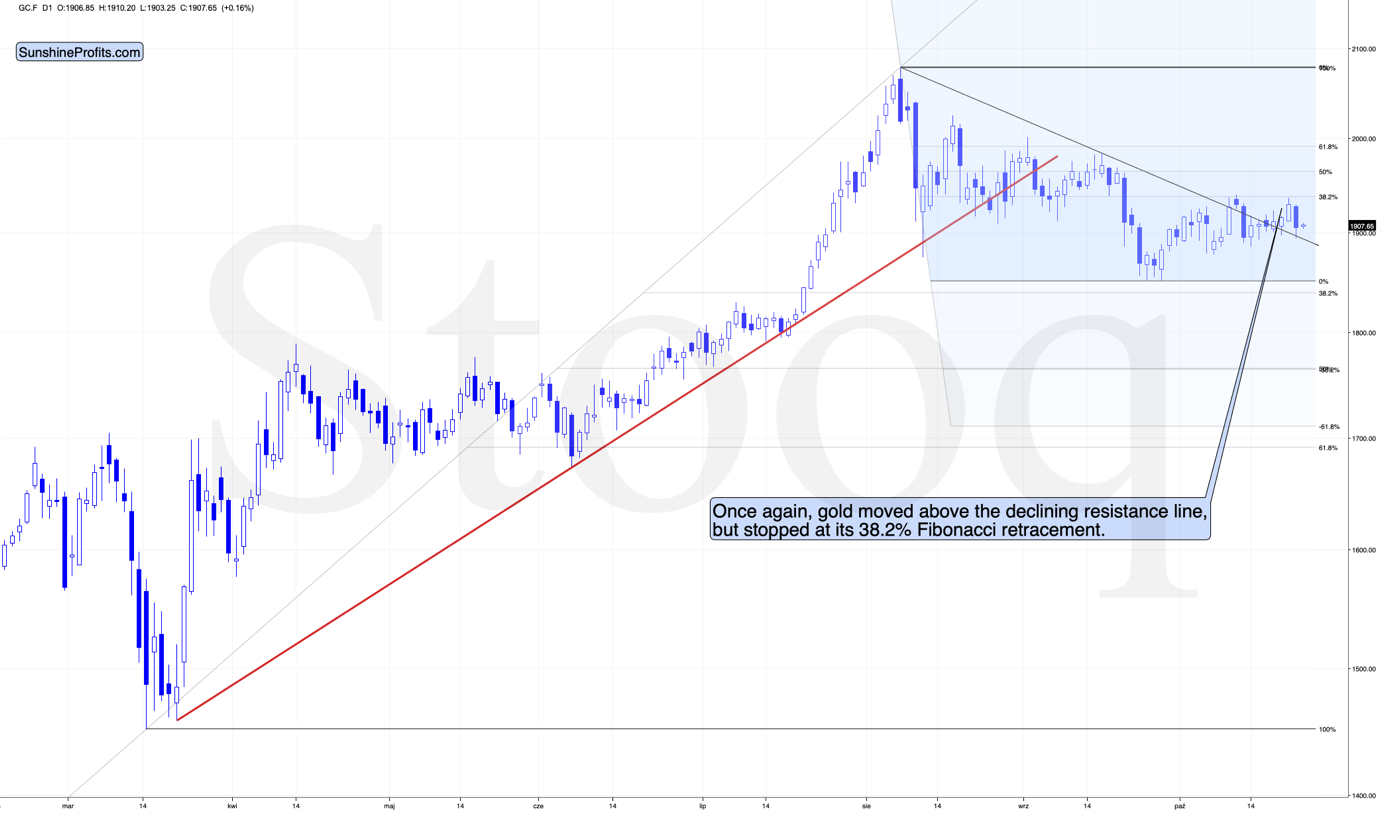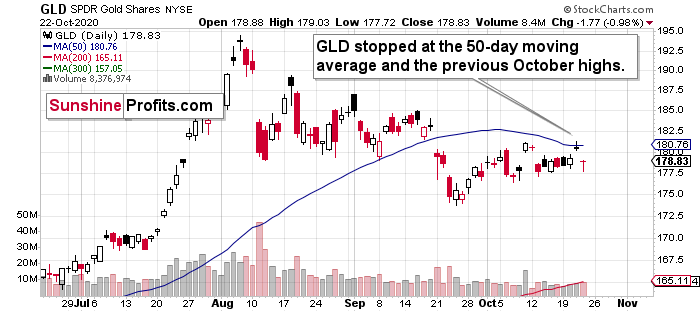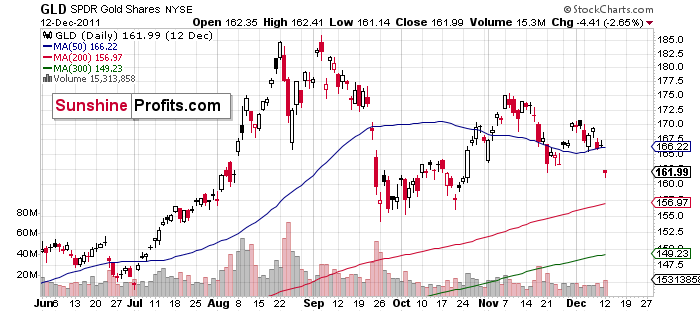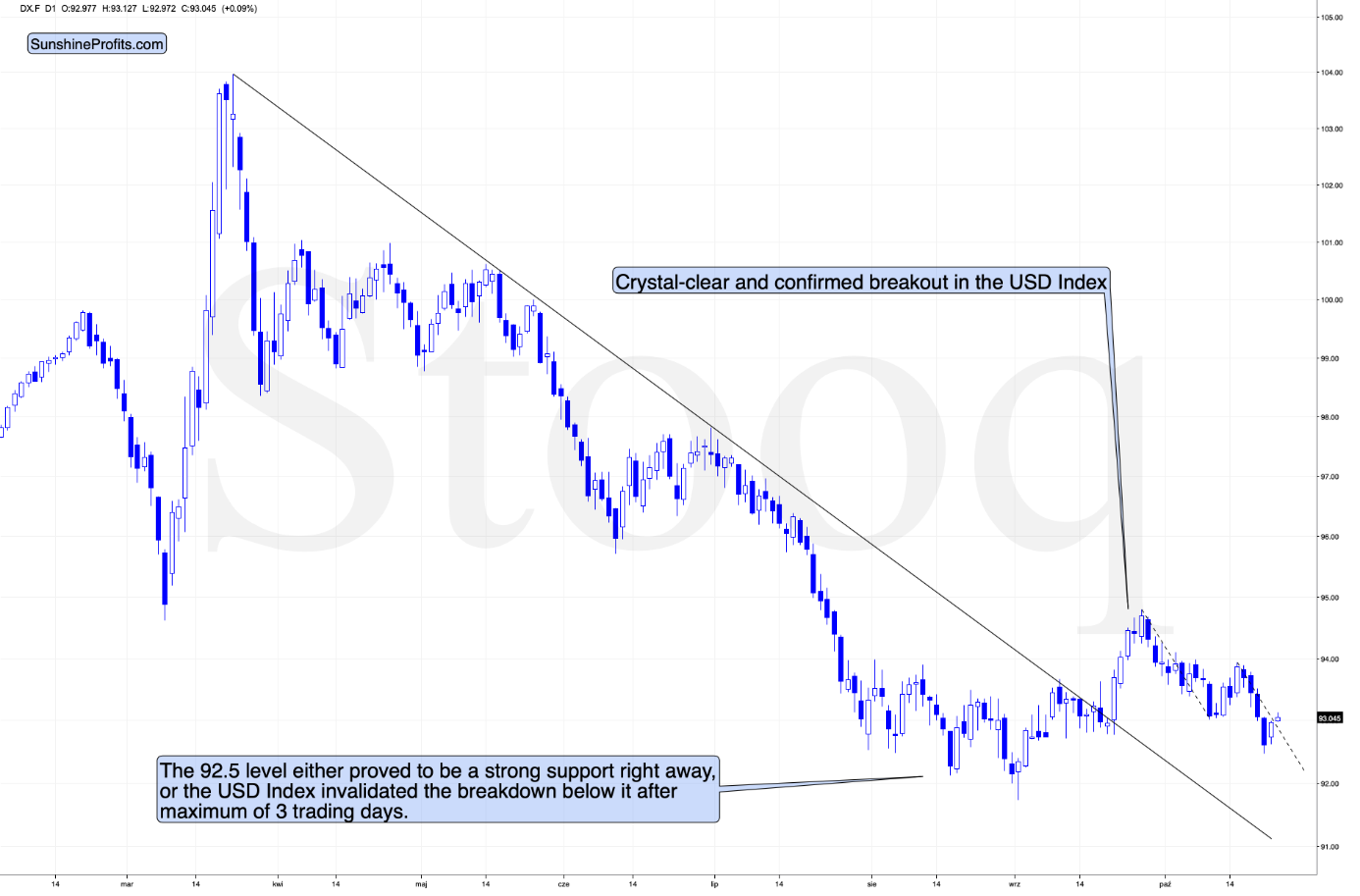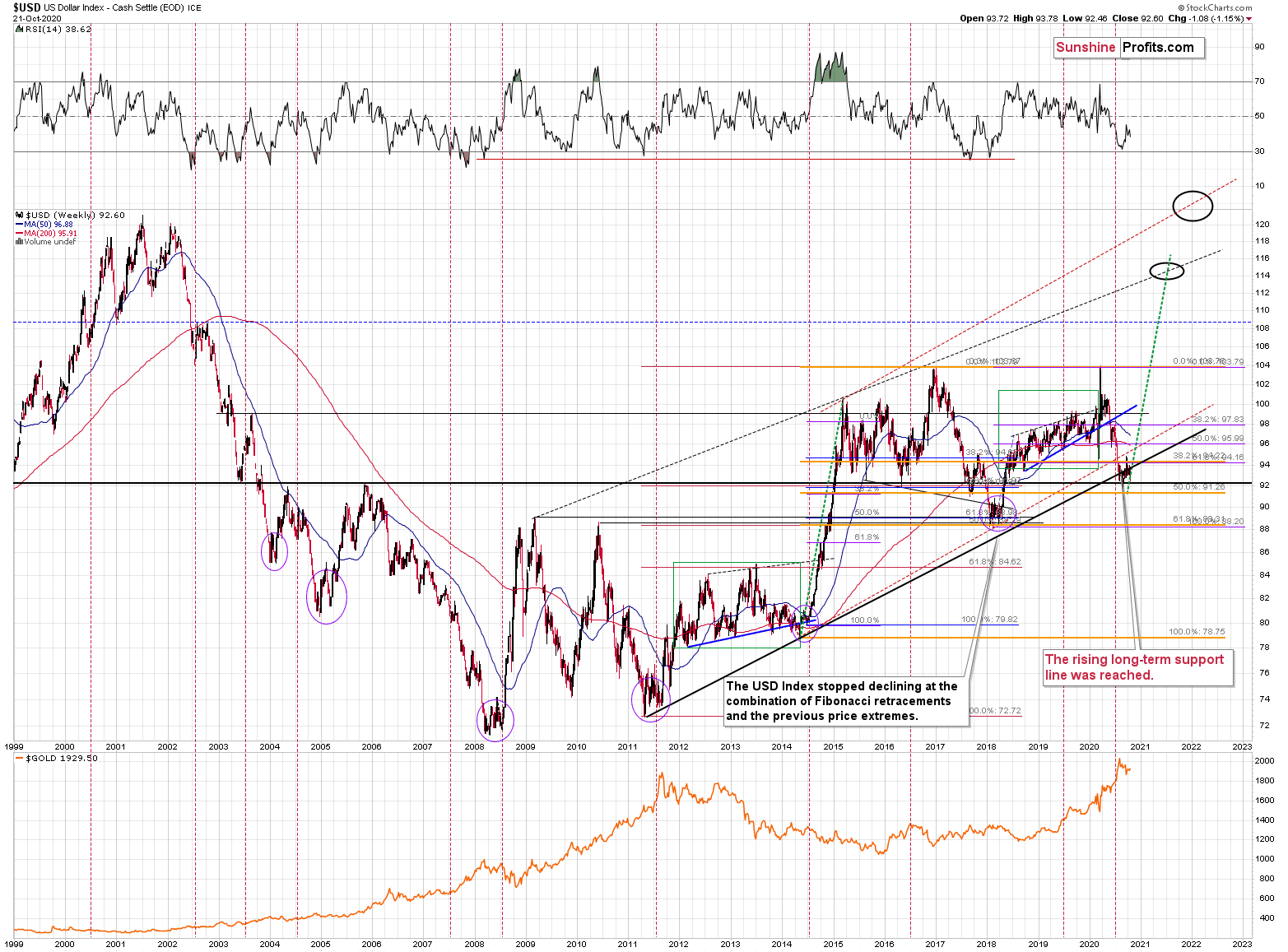Briefly: in our opinion, full (300% of the regular position size) speculative short positions in mining stocks are justified from the risk/reward point of view at the moment of publishing this Alert.
Since the situation developed in tune with my expectations from yesterday, today’s analysis will be based mainly on yesterday’s analysis, which remains valid.
The key takeaway from yesterday’s remarks was that miners’ relative weakness (on a short-term basis) nullified the bullish implications of gold’s breakout. Thus, the situation didn’t become more bullish because of that, at least as far as the mining stocks are concerned.
And indeed, yesterday, gold and silver mining stocks declined along with the underlying metals. To provide you with a better context, here’s what we indicated yesterday:
Yesterday, the GDX ETF (which we’ll use as a proxy for the sector) moved higher ($0.95) but gave away most of its gains ($0.49) before the session was over, ultimately closing merely $0.46 higher. This means that miners have barely closed above their Friday’s closing price. As a matter of fact, they didn’t even move close to the October high.
Miners’ weakness is something that heralds precious metals market declines, and such was the case back in early March. As you can see on the chart above, the GDX ETF didn’t move back to its previous highs in March – even though at the same time, gold moved slightly above its previous highs. And we are all well aware of the carnage that followed.
So far, gold’s reaction resembles what happened in early March – it declined quite profoundly yesterday, erasing more than its previous daily gains.
Gold stopped at the previously broken declining resistance line, which seems bullish. But, as we explained yesterday, that is not precisely bullish due to miners’ weakness, which accompanied the breakout.
The chart above shows us that the GLD has just tested its October highs and its 50-day moving average, proving to be a strong resistance. Back in early September, this MA served as a support, and when it was finally breaking in mid-September, it was then followed by a quite visible decline. Right now, this makes it quite a potent resistance, and it’s not surprising that gold declined after reaching it.
Additionally, please also take into account that the GLD bounces off relatively similar price levels. In August and early September, the 180-level and its surrounding served as support, and subsequently – in October – it served as resistance. There’s a good reason why that’s the case.
Namely, these are the levels that stopped GLD’s rally back in 2011. This is where we saw the ultimate top. It formed a bit north of $180, but the overall area remains the same.
And what are the implications for the current situation because of it? That the resistance that gold and GLD just reached is stronger than it appears at first sight.
Currently, gold is trying to climb back above its 2011 highs, and the attempt is not a successful one for now. Even at the moment of writing these words, gold futures are trading below their 2011 high.
So, is there any other indication that gold and miners are about to turn south? You can bet there is.
It is not only the mining stocks – gold link that points to lower PM prices. The gold-USD link that points to it as well.
Yesterday, we commented on the above chart in the following manner:
The USD Index might have already bottomed, or it might not have bottomed at all. Before dismissing the above sentence as non-informative, let us add that even if it didn’t bottom yet, it’s likely that it will bottom and reverse its course pretty soon.
And why is that? It’s because of the price level that it reached yesterday. Namely, it moved to about 92.5. Why would this be of any significance? Because earlier this year, the 92.5 level either proved to be robust support right away or the USD Index invalidated the breakdown below it after a maximum of 3 trading days.
The above remains up-to-date, except that based on yesterday’s rebound, it’s a bit more likely that the bottom is already in (again, it’s not a sure bet).
At first sight, the USDX’s move higher in today’s pre-market trading is not that important. However, when one notices that this move higher also means invalidation of the breakdown below the previous October low, it suddenly does become important and bullish. When the situation is getting more bullish for the USDX, it means that it’s betting more bearish for the PMs as a result.
Besides, even if the USD Index doesn’t rally right away, it’s still likely to do a short rally, i.a. based on its long-term chart, which I described yesterday in the following way:
Moreover, in the preceding years, many times before this level (proximity of 92.5) served as resistance and support.
The strength of this level as support (and resistance) in the long run and in case of the recent developments makes it incredibly strong in the current circumstances.
Consequently, the USD Index outlook remains bullish, and the outlook for the precious metals sector remains bearish.
You might wonder, from what levels is the USD Index likely to rally? From the current levels, after re-testing the early-September low, or it could bottom between these prices. It’s very likely that the USD Index would not be able to confirm the breakdown below the 92.5 level, just like it was unable to do it in early September. Consequently, we will view a brief move below this level as a buying opportunity for the USD Index, and as a good shorting opportunity for the mining stocks.
All in all, given the limited bullish and the sizable bearish potentials, from today’s point of view, the bearish outlook for the mining stocks continues to be justified.
Letters to the Editor
Q: If Pelosi and Mnuchin agree on a stimulus package then all markets will rise. If it passes the Senate markets will explode upward. If this happens how can being short work for us?
A: Generally, the stimulus is obvious, and therefore, it's almost certainly already reduced in the prices. Consequently, just like the SLV ETF launch didn't skyrocket the silver price (conversely, it plunged), the next round of stimulus might not generate any rally in gold, or the rally that we will see is going to be nothing more than a bull trap - something similar to what we saw in 2016 right after the US presidential elections.
Q: Market is looking to rally, positive earnings, recovery in China and lots of other positives.
A: Whether it's looking to rally or not is a question of a big debate. It’s not a safe bet, or better yet, just an assumption that I'd use. A simultaneous "recovery" in China means that even there, things are worse than they were before 2020. And what about the rest of the world? Much, much worse, I’m afraid. So why would stocks rally above their closing price of 2019? They are above it, which suggests that perhaps they are trading too high right now.
Q: Election uncertainty that can only be positive for GOLD
A: Yes. This uncertainty is already here, which means that gold's price is higher than it would be if the unpredictability was not present. The uncertainty is going away in about two weeks, consequently removing one of the bullish factors. This remains to be bearish for the next several weeks/the remainder of the year.
Q: What am I missing that you are seeing that keeps you so committed to this trade?
A: I'm committed to this trade due to reasons provided in the flagship Gold & Silver Trading Alerts. That's exactly why I'm providing them in their current form - to keep the reasons visible. I think that we're going to see a repeat of what we already witnessed earlier this year - a sharp decline followed by another move up, and these moves are worth the waiting. Of course, the above is only my opinion, and everyone is free to adjust. You can decrease the size of your trade, or even close it entirely. It's your capital, and I'm just a free market advocate.
Overview of the Upcoming Decline
As far as the current overview of the upcoming decline is concerned, I think it has already begun.
During the final part of the slide (which could end later than in 6 weeks, perhaps near the end of the year – just like it happened in 2015), we expect silver to decline more than miners. That would align with how the markets initially reacted to the Covid-19 threat.
The impact of all the new rounds of money printing in the U.S. and Europe on the precious metals prices is incredibly positive in the long run, which does not make the short-term decline improbable. Markets can and will get ahead of themselves and decline afterward – sometimes very profoundly – before continuing with their upward climb.
The plan is to exit the current positions in miners after they decline far and fast, but at the same time, silver drops just “significantly” (we expect this to happen in 0 – 5 weeks). In other words, the decline in silver should be severe, but the decline in the miners should look “ridiculous”. That’s what we did in March when we bought practically right at the bottom. It is soft, but at the same time, a broad instruction, so additional confirmations are necessary.
I expect this confirmation to come from gold, reaching about $1,800. If – at the same time – gold moves to about $1,800 and miners are already after a ridiculously big drop (say, to $31 - $32 in the GDX ETF – or lower), we will probably exit the short positions in the miners and at the same time enter short positions in silver. It will be tempting to wait with opening the short position in silver until the entire sector rebounds, but such a rebound could last only a couple of hours, so it would be challenging to successfully execute such a strategy.
The precious metals market's final bottom is likely to take shape when gold shows significant strength relative to the USD Index. It could take the form of a gold’s rally or a bullish reversal, despite the ongoing USD Index rally.
Summary
Summing up, given the recent move higher in the general stock market, it could be the case that the decline is delayed, but there are also signs pointing to the corrective upswing being already over, just like the visible mining stocks underperformance and the very recent USD Index breakout verification.
Considering gold's breakout invalidation above the 2011 highs, it's evident that the big rally (that ended $4 above our upside target) is entirely over. Given this invalidation and the confirmed USD Index breakout, gold will probably slide much lower over the next few weeks. There are indications that the corrective upswing in the precious metals market and the USDX pullback are close to being over, so the decline could resume any day – or hour – now.
Naturally, everyone's trading is their responsibility. But in our opinion, if there ever was a time to either enter a short position in the miners or increase its size if it was not already sizable, it's now. We made money on the March decline, and on the March rebound, with another massive slide already underway.
After the sell-off (that takes gold to about $1,700 or lower), we expect the precious metals to rally significantly. The final decline might take as little as 1-6 weeks, so it's important to stay alert to any changes.
Most importantly, please stay healthy and safe. We made a lot of money on the March decline and the subsequent rebound (its initial part) price moves (and we'll likely earn much more in the following weeks and months), but you have to be healthy to enjoy the results.
As always, we'll keep you - our subscribers - informed.
To summarize:
Trading capital (supplementary part of the portfolio; our opinion): Full speculative short positions (300% of the full position) in mining stocks is justified from the risk to reward point of view with the following binding exit profit-take price levels:
Senior mining stocks (price levels for the GDX ETF): binding profit-take exit price: $32.02; stop-loss: none (the volatility is too big to justify a SL order in case of this particular trade); binding profit-take level for the DUST ETF: $28.73; stop-loss for the DUST ETF: none (the volatility is too big to justify a SL order in case of this particular trade)
Junior mining stocks (price levels for the GDXJ ETF): binding profit-take exit price: $42.72; stop-loss: none (the volatility is too big to justify a SL order in case of this particular trade); binding profit-take level for the JDST ETF: $21.22; stop-loss for the JDST ETF: none (the volatility is too big to justify a SL order in case of this particular trade)
For-your-information targets (our opinion; we continue to think that mining stocks are the preferred way of taking advantage of the upcoming price move, but if for whatever reason one wants / has to use silver or gold for this trade, we are providing the details anyway. In our view, silver has greater potential than gold does):
Silver futures downside profit-take exit price: unclear at this time - initially, it might be a good idea to exit, when gold moves to $1,703.
Gold futures downside profit-take exit price: $1,703
Long-term capital (core part of the portfolio; our opinion): No positions (in other words: cash
Insurance capital (core part of the portfolio; our opinion): Full position
Whether you already subscribed or not, we encourage you to find out how to make the most of our alerts and read our replies to the most common alert-and-gold-trading-related-questions.
Please note that we describe the situation for the day that the alert is posted in the trading section. In other words, if we are writing about a speculative position, it means that it is up-to-date on the day it was posted. We are also featuring the initial target prices to decide whether keeping a position on a given day is in tune with your approach (some moves are too small for medium-term traders, and some might appear too big for day-traders).
Additionally, you might want to read why our stop-loss orders are usually relatively far from the current price.
Please note that a full position doesn't mean using all of the capital for a given trade. You will find details on our thoughts on gold portfolio structuring in the Key Insights section on our website.
As a reminder - "initial target price" means exactly that - an "initial" one. It's not a price level at which we suggest closing positions. If this becomes the case (like it did in the previous trade), we will refer to these levels as levels of exit orders (exactly as we've done previously). Stop-loss levels, however, are naturally not "initial", but something that, in our opinion, might be entered as an order.
Since it is impossible to synchronize target prices and stop-loss levels for all the ETFs and ETNs with the main markets that we provide these levels for (gold, silver and mining stocks - the GDX ETF), the stop-loss levels and target prices for other ETNs and ETF (among other: UGLD, DGLD, USLV, DSLV, NUGT, DUST, JNUG, JDST) are provided as supplementary, and not as "final". This means that if a stop-loss or a target level is reached for any of the "additional instruments" (DGLD for instance), but not for the "main instrument" (gold in this case), we will view positions in both gold and DGLD as still open and the stop-loss for DGLD would have to be moved lower. On the other hand, if gold moves to a stop-loss level but DGLD doesn't, then we will view both positions (in gold and DGLD) as closed. In other words, since it's not possible to be 100% certain that each related instrument moves to a given level when the underlying instrument does, we can't provide levels that would be binding. The levels that we do provide are our best estimate of the levels that will correspond to the levels in the underlying assets, but it will be the underlying assets that one will need to focus on regarding the signs pointing to closing a given position or keeping it open. We might adjust the levels in the "additional instruments" without adjusting the levels in the "main instruments", which will simply mean that we have improved our estimation of these levels, not that we changed our outlook on the markets. We are already working on a tool that would update these levels daily for the most popular ETFs, ETNs and individual mining stocks.
Our preferred ways to invest in and to trade gold along with the reasoning can be found in the how to buy gold section. Furthermore, our preferred ETFs and ETNs can be found in our Gold & Silver ETF Ranking.
As a reminder, Gold & Silver Trading Alerts are posted before or on each trading day (we usually post them before the opening bell, but we don't promise to do that each day). If there's anything urgent, we will send you an additional small alert before posting the main one.
Thank you.
Sincerely,
Przemyslaw Radomski, CFA
Editor-in-chief, Gold & Silver Fund Manager


